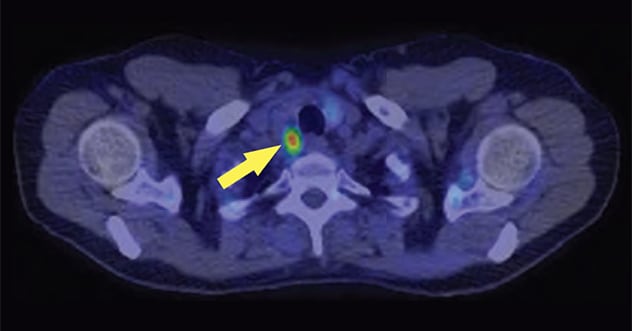Oct. 22, 2019
Primary hyperparathyroidism (PHPT) is a common endocrine disorder that has demonstrated a recent increase in incidence rate — likely due to PHPT screening in patients being evaluated for osteoporosis. If untreated, approximately 30% of patients with PHPT will demonstrate disease progression. Some patients can have associated significant morbidity due to osteoporotic fractures, nephrolithiasis, neuropsychiatric disorders and other common but nonspecific symptoms.
Although surgical excision is curative, precise preoperative localization is often challenging due to the small size and variable location of parathyroid adenomas, which can be located throughout the neck or mediastinum and are often only slightly larger than a normal gland. In up to 25% of patients, especially those with mild forms of PHPT, multigland parathyroid disease is encountered. These factors contribute to approximately 10% of patients failing initial surgery using conventional preoperative imaging techniques. In such cases, repeat surgical exploration is less likely to be successful and may impart a higher risk of complications in addition to increased expense.
In an effort to improve treatment of parathyroid disease, a multidisciplinary team of radiologists, endocrinologists and endocrine surgeons at Mayo Clinic in Rochester, Minnesota, has adopted a novel imaging technique using carbon-11-choline — 11C-choline — positron emission tomography/computerized tomography (PET/CT). 11C-choline is a nuclear medicine radiotracer approved by the Food and Drug Administration and the Centers for Medicare & Medicaid Services for restaging biochemically recurrent prostate cancer. Since its clinical introduction in 2012, 11C-choline PET/CT has demonstrated utility in a variety of disease processes and has shown particular promise in parathyroid imaging.
Ahmad Parvinian, M.D., with Diagnostic Radiology at Mayo Clinic in Rochester, Minnesota, says, "In a 2018 publication in the American Journal of Roentgenology, we summarized our experience with 7,088 11C-choline PET/CT examinations in 2,933 consecutive patients undergoing PET/CT for biochemically recurrent prostate cancer between January 2005 and February 2016. In this group, we identified 13 patients with pathologically or laboratory-proven parathyroid adenomas."
Geoffrey B. Johnson, M.D., Ph.D., with Nuclear Medicine at Mayo Clinic in Rochester, Minnesota, elaborates: "11C-choline PET/CT proved 100% sensitive for detection of abnormal parathyroid glands. The adenomas demonstrated maximum standardized uptake values that averaged twice as high as the adjacent thyroid glands and four times higher than the blood pool, generating visually appealing images with a high signal compared with the background.
"The lesions identified in this study averaged 9 mm by 6 mm in size and included a mediastinal ectopic adenoma as well as an adenoma weighing only 50 mg — slightly larger than the accepted upper limit of a normal parathyroid gland at 30 mg. Two patients who underwent parathyroidectomy had subsequent 11C-choline PET/CT examinations, and in both cases the focal choline uptake corresponding to the suspected adenomas resolved on the follow-up scan.
"In addition to high sensitivity for localization of abnormal parathyroid glands, the advantages of 11C-choline PET/CT over conventional parathyroid imaging modalities include its speed, with imaging completed in less than 15 minutes as opposed to several hours in other nuclear medicine examinations, as well as its low radiation dose relative to conventional nuclear techniques and CT. Moreover, there have been no adverse events or evidence of toxicity in the more than 3,000 patients who have undergone 11C-choline PET/CT at our institution."
Focal choline uptake posterior to the right thyroid lobe corresponding to a parathyroid adenoma

Focal choline uptake posterior to the right thyroid lobe corresponding to a parathyroid adenoma
Conspicuous focal choline uptake posterior to the right thyroid lobe corresponding to a parathyroid adenoma in a 74-year-old male patient with elevated serum parathyroid hormone and calcium levels.
Robert A. Wermers, M.D., chair of Endocrinology, Diabetes, Metabolism, and Nutrition at Mayo Clinic in Rochester, Minnesota, adds, "Since publishing our initial experience, we have begun using 11C-choline PET/CT for preoperative localization of parathyroid adenomas in selected patients, including those with persistent PHPT that is not localized by other imaging modalities such as ultrasonography, parathyroid scans and dynamic (4D) CT scans.
"A recent demonstration of the benefit of this new imaging method was seen in a 56-year-old woman who presented to our clinic with persistent PHPT with a serum calcium level as high as 11.7 mg/dL, hypophosphatemia, marked hypercalciuria and a parathyroid hormone that was fourfold elevated."
Stephen D. Cassivi, M.D., M.S., with Thoracic Surgery at Mayo Clinic in Rochester, Minnesota, expands, "Multiple imaging modalities, including a neck ultrasound, parathyroid scan and 4D CT, failed to localize the source of her disease. The patient underwent 11C-choline PET/CT that revealed an ectopic mediastinal parathyroid adenoma within the thymus, accounting for her persistent hyperparathyroidism. Subsequent thoracoscopy and resection of the ectopic parathyroid gland proved curative."
Dr. Wermers concludes, "Our experience suggests that 11C-choline PET/CT is a sensitive, safe, low-dose and fast preoperative imaging option in patients with hyperparathyroidism and suspected parathyroid adenomas. We hope to expand access to this exciting technique for more patients in the near future."
For more information
Parvinian A, et al. 11C-choline PET/CT for detection and localization of parathyroid adenomas. American Journal of Roentgenology. 2018;210:418.